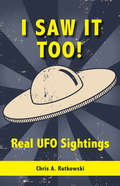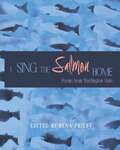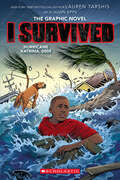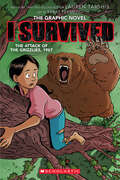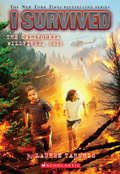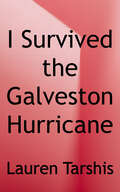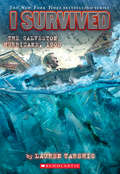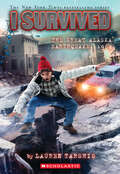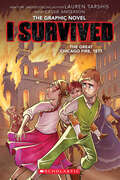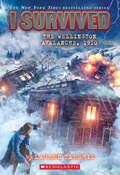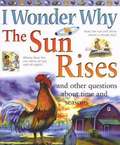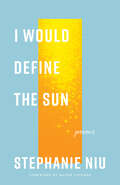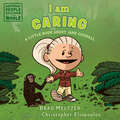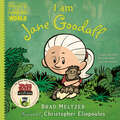- Table View
- List View
I Saw It Too!: Real UFO Sightings
by Chris A. RutkowskiAlthough many adults believe they have had encounters with strange creatures from alien spaceships, not everyone has actually reported their experiences to official investigators. But if you’re a young person it’s even less likely that people will believe you and more likely that your story will never be officially recorded. After all, who would believe a kid? I Saw It Too! is the first collection of stories told by children, documenting what they saw and when they saw it. These accounts are real cases of UFOs they’ve seen or alien creatures they’ve encountered that were reported to government or military officials, UFO investigators, and journalists. Inside you will find eighteen of these strange, fascinating, and believable tales recounted by young people from around the world with story illustrations by Stacey Archer with Lonigan Gilbert. The truth is really out there, and renowned ufologist Chris Rutkowski has tracked it down!
I Saw You Standing There: Green Mountain Book 3 (Green Mountain)
by Marie ForceFrom New York Times bestselling author Marie Force, creator of the beloved McCarthys of Gansett Island, Quantum and Fatal series, comes the third book in her Green Mountain series. Fans of Debbie Macomber, Susan Mallery and Jill Shalvis will love the heartwarming, sexy romance series centered on the lives of the Abbott family. There's a budding romance on Butler Mountain, but in the Abbott family, keeping something under wraps is no easy feat... Colton Abbott and Lucy Mulvaney have a secret. Colton's siblings have begun to figure it out, but it's not like Lucy to keep things from those closest to her - especially her best friend, Cameron. Cam recently moved in with her true love, Will Abbott. But Lucy isn't about to tell Cam she's having a fling...with Will's brother. Flitting between New York and Vermont is exhausting, so Lucy is looking forward to a weekend with Colton at the Abbott family lake house. Too bad Will and Cameron have the same idea... With their secret out, will Lucy and Colton's clandestine romance lose its appeal or this the start of something lasting?Bonus Content: Features A Green Mountain Short Story! (Published in the USA as Lucy In The Sky With Diamonds) ***I Saw You Standing There is published in the USA as I Saw Her Standing There***For more spellbinding Green Mountain romance, check out the whole series: Your Love Is All I Need, Let Me Hold Your Hand, I Saw You Standing There, And I Love You, You'll Be Mine, It's Love, Only Love and Ain't She Sweet.
I Sing the Salmon Home: Poems from Washington State
by Rena PriestThis anthology brings together a wide assortment of poems that celebrate, mourn, and seek to preserve the salmon of the US Northwest. The editor writes, "It is my hope that the poems in this collection will carry into the hearts of readers a wish to preserve and protect the gifts of salmon bestowed by a beautiful living earth; that they will provide the spark of life to carry us into a new cycle."
I Stink!
by Kate Mcmullan Jim McmullanFollow a night in the life of a cool garbage truck with a bad attitude as he makes the rounds and picks up an A-to-Z list of stinky garbage.
I Stink!
by Kate McMullanNow a streaming animated series!For fans of Goodnight, Goodnight, Construction Site and Steam Train, Dream Train comes a noisy addition to the hilarious read-aloud series from Kate and Jim McMullan, the popular creators of I’m Bad! and I’m Dirty!“Know what I do at night while you’re asleep? Eat your trash, that’s what!”With ten wide tires, one really big appetite, and an even bigger smell, this truck’s got it all. His job? Eating your garbage and loving every stinky second of it! And you thought nighttime was just for sleeping.
I Survived Hurricane Katrina, 2005: A Graphic Novel (I Survived Graphix)
by Lauren TarshisThe story of a boy, a dog, and the storm of the century is brought vividly to life in this graphic novel adaptation of Lauren Tarshis's bestselling I Survived Hurricane Katrina, 2005, with text adapted by Georgia Ball.Barry's family tries to evacuate before Hurricane Katrina hits their home in New Orleans. But when his little sister gets terribly sick, they're forced to stay home and wait out the storm.At first, Katrina doesn't seem to be as bad as predicted. But overnight the levees break, and Barry's world is literally torn apart. He's swept off by the floodwaters, away from his family. Can he survive the storm of the century — alone?Lauren Tarshis's New York Times bestselling I Survived series comes to vivid life in graphic novel editions. Perfect for readers who prefer the graphic novel format, or for existing fans of the I Survived chapter book series, these graphic novels combine historical facts with high-action storytelling that's sure to keep any reader turning the pages. Includes a nonfiction section at the back with facts and photos about the real-life event.
I Survived the Attack of the Grizzlies, 1967: A Graphic Novel (I Survived Graphic Novels)
by Lauren TarshisA gripping graphic novel adaptation of Lauren Tarshis's bestselling I Survived the Attack of The Grizzlies, 1967, with text adapted by Georgia Ball.No grizzly has ever killed a human in Glacier National Park before... until tonight. Eleven-year-old Melody Vega and her family come to Glacier every year. Mel loves it here — the beautiful landscapes and wildlife make it easy to forget her real-world troubles. But this year is different. With Mom gone, every moment in the park is a reminder of the past.Then Mel comes face-to-face with a mighty grizzly. She knows basic bear safety: Don't turn your back. Don't make any sudden movements. And most importantly: Don't run.That last one is the hardest for Mel; she's been running from her problems all her life. If she wants to survive tonight, she'll have to find the courage to face her fear.Based on the real-life grizzly attacks of 1967, this bold graphic novel tells the story of one of the most tragic seasons in the history of America's national parks — a summer of terror that forever changed ideas about how grizzlies and humans can exist together in the wild.Lauren Tarshis's New York Times bestselling I Survived series comes to vivid life in graphic novel editions. Perfect for readers who prefer the graphic novel format, or for existing fans of the I Survived chapter book series, these graphic novels combine historical facts with high-action storytelling that's sure to keep any reader turning the pages. Includes a nonfiction section at the back with facts and photos about the real-life event.
I Survived the California Wildfires, 2018 (I Survived #20)
by Lauren TarshisCalifornia continues to be ravaged by devastating wildfires. Lauren Tarshis's heart-pounding story tells of two children who battle the terrifying flames and -- despite the destruction -- find hope in the ashes.The people of Northern California were used to living with the threat of wildfires. But nothing could have prepared them for the devastating 2018 fire season, the deadliest in 100 years and the most destructive in history.In the 20th I Survived book, readers join eleven-year-old Josh as he leaves his New Jersey home for the rural northern California town where his cousins live. Still reeling from the life-changing challenges that propelled him and his mother across the country, Josh struggles to adapt to a more rustic, down-to-earth lifestyle that couldn't be more different from the one he is used to.Josh and his cousin bond over tacos and reptiles and jokes, but on a trip into the nearby forest, they suddenly find themselves in the path of a fast-moving firestorm, a super-heated monster that will soon lay waste to millions of acres of wilderness and -- possibly -- their town. Josh needs to confront the family issues burning him up inside, but first he'll have to survive the flames blazing all around him.
I Survived the Galveston Hurricane, 1900 (I Survived Ser. #21)
by Lauren TarshisMore than a century later, the Galveston Hurricane of 1900 is still America's deadliest disaster. Lauren Tarshis's story of one child surviving the horrible event churns with page-turning action and bold hope. The city of Galveston, Texas, was booming. Perched on an island off the southern coast of Texas, Galveston had been founded in the 1830s. By 1900, it was Texas's richest and most important city. Boats loaded up with American cotton and wheat steamed from Galveston to countries around the world. Arriving ships were crowded with immigrants. The streets, paved with crushed oyster shells, sparkled like they'd been sprinkled with diamonds. True, this glittering city was prone to flooding. But just a few years before, a weather forecaster had said the idea of a hurricane striking Galveston was absurd. So when a storm started brewing on September 8, 1900, no one believed it would be any worse than previous storms. They gathered on the beach to cheer on the wild waves. But what started as entertainment soon turned into a nightmare as those wild waves crashed into the city. By morning, hundreds of homes were destroyed. Eight thousand people were dead. The city had all but disappeared, In this thrilling installment of Lauren Tarshis's New York Times bestselling I Survived series, one child finds safety only to head back into the treacherous waters to make sure his neighbors are safe.
I Survived the Galveston Hurricane, 1900 (I Survived)
by Lauren TarshisMore than a century later, the Galveston Hurricane of 1900 is still America's deadliest disaster. Lauren Tarshis's story of one child surviving the horrible event churns with page-turning action and bold hope.The city of Galveston, Texas, was booming. Perched on an island off the southern coast of Texas, Galveston had been founded in the 1830s. By 1900, it was Texas's richest and most important city. Boats loaded up with American cotton and wheat steamed from Galveston to countries around the world. Arriving ships were crowded with immigrants. The streets, paved with crushed oyster shells, sparkled like they'd been sprinkled with diamondsTrue, this glittering city was prone to flooding. But just a few years before, a weather forecaster had said the idea of a hurricane striking Galveston was absurd.So when a storm started brewing on September 8, 1900, no one believed it would be any worse than previous storms. They gathered on the beach to cheer on the wild waves. But what started as entertainment soon turned into a nightmare as those wild waves crashed into the city. By morning, hundreds of homes were destroyed. Eight thousand people were dead. The city had all but disappeared.In this thrilling installment of Lauren Tarshis's New York Times bestselling I Survived series, one child finds safety only to head back into the treacherous waters to make sure his neighbors are safe.
I Survived the Great Alaska Earthquake, 1964 (I Survived)
by Lauren TarshisThe Great Alaska Earthquake is the largest and most powerful recorded earthquake in US history. Lauren Tarshis's story of one child surviving this terrifying natural disaster pounds with page-turning action and heartwarming hope.It was 1964 in the brand-new state of Alaska, a vast land of staggering beauty and heart-stopping dangers. Eleven-year-old Jack had grown up living happily with his parents in an off-the-grid cabin, miles from their closest neighbors. Grizzlies and wolves outnumbered people, and dark winter days were 30 degrees below zero. Jack had always thought of himself as strong -- “Alaska tough”. But then the most powerful earthquake in American history -- the Good Friday Earthquake -- struck. The 9.2 magnitude quake lasted nearly five minutes, destroying downtown Anchorage and sending 30-foot tsunamis into coastal cities, wiping out entire communities. Its vibrations were felt around the world. In the end, it caused billions of dollars in damage and the death of 129 people.New York Times bestselling author Lauren Tarshis tells the story of the disaster that changed our understanding of earth science -- and tested one boy in ways he never could have imagined. Includes a section of nonfiction backmatter with more facts and photos about the real-life event.
I Survived the Great Chicago Fire, 1871 (I Survived Graphix)
by Lauren TarshisCould an entire city really burn to the ground? One brave boy finds out in this graphic novel adaptation of Lauren Tarshis's bestelling I Survived the Great Chicago Fire, 1871, with text adapted by Georgia Ball and art by Cassie Anderson.Oscar Starling never wanted to move to Chicago. The smog, the stench, the thieves around every corner -- it’s so different from his old life on the farm. Will the big city ever feel like home? But shortly after Oscar arrives, a huge fire breaks out. All of Chicago is ablaze and one thing is clear: the city is like a powder keg, ready to explode. An army of firemen tries to help, but this fire is a ferocious beast that wants to devour everything in its path. Will Oscar -- and his new city and new friends -- survive one of the most famous and devastating fires in history? Lauren Tarshis's New York Times bestselling I Survived series comes to vivid life in graphic novel editions. Perfect for readers who prefer the graphic novel format, or for existing fans of the I Survived chapter book series, these graphic novels combine historical facts with high-action storytelling that's sure to keep any reader turning the pages. Includes a nonfiction section at the back with facts and photos about the real-life event.
I Survived the Wellington Avalanche, 1910 (I Survived)
by Lauren TarshisThe Wellington snow slide of 1910 was—and still is—the deadliest avalanche in America’s history. Lauren Tarshis's story of one child surviving the frozen nightmare pounds with page-turning action and heartwarming hope.The snow came down faster than train crews could clear the tracks, piling up in drifts 20 feet high. At the Wellington train depot in the Cascade Mountains, two trains sat stranded, blocked in by snow slides to the east and west. Some passengers braved the storm to hike off the mountain, but many had no choice but to wait out the storm.But the storm didn’t stop. One day passed, then two, three . . . six days. The snow turned to rain. Then, just after midnight on March 1, a lightning storm struck the mountain, sending a ten-foot-high wave of snow barreling down the mountain. The trains tumbled 150 feet. 96 people were dead.The Wellington avalanche forever changed railroad engineering. New York Times bestselling author Lauren Tarshis tells the tale of one girl who survived, emerging from the snow forever changed herself.
I Will Find You (A Seal Island novel): A captivating love story from the author of THE ITALIAN VILLA
by Daniela SacerdotiFrom the bestselling author of The Italian Villa and Watch Over Me, a beautiful, heartrending story of finding love against all odds. Perfect for anyone who loves Fiona Valpy and Lily Graham.'Atmospheric, romantic and compelling. Daniela writes with huge warmth and sincerity' Rosanna LeyAfter her mother dies, heartbroken Cora discovers she has been left a cottage on a remote Scottish isle called Seal. The moment she arrives, she falls under the island's spell... and finds herself drawn to a brooding stranger. For wanderer Innes, returning to the island means confronting the demons of his past. He knows he can't offer beautiful Cora anything more than a collection of moments - yet he can't deny the immediate intensity of their connection.As Cora begins to trace her mother's roots, she learns Gealach Cottage has a turbulent history. Another young woman had sought refuge here, waiting for her lover to return. What became of her? Only by unravelling a forgotten story of passion and courage can Cora understand what has pulled her to Seal... and to a man who feels like home.Readers love the breathtaking novels of Daniela Sacerdoti:'Mesmerising! I was totally hooked... absolutely perfect and just flowed endlessly with such ease. I really can't praise this OUTSTANDING book enough!' Goodreads reviewer, 5 stars'Every time I read a Daniela Sacerdoti, it leaves a hollow in my chest where my heart used to be as her writing melts my heart completely. EVERY. SINGLE. TIME.' Goodreads reviewer, 5 stars'The first book I've ever wanted to read again before I've even finished turning the last page; this book will stay with me forever.' Goodreads reviewer, 5 stars'This is a beautiful, magical, enchanting book. I have been waiting for something like this for so long.' Goodreads reviewer, 5 starsThis is a poignant, ethereal and beautifully written novel about letting go and moving on. A story that I was still thinking about a few days later!' Goodreads reviewer, 5 stars'I love these books!! I keep thinking that they can't be as good as the last one but every one is as wonderful as the one before.' Goodreads reviewer, 5 stars'This is an amazing book. A real page turner. I can't say anything else but you must read.' Goodreads reviewer, 5 stars
I Will Find You (A Seal Island novel): A captivating love story from the author of THE ITALIAN VILLA
by Daniela SacerdotiA woman on the run. An island of secrets. A love to defy all odds...From the bestselling author of WATCH OVER ME, Daniela Sacerdoti's new novel is a romantic, heartrending, epic story that will sweep you away to the beautiful, mysterious island of Seal. If you love the novels of Rosanna Ley, Tracy Rees and Lulu Taylor, you will adore Daniela Sacerdoti.** Over 1 million copies sold of Daniela Sacerdoti's novels **Two different women, divided by time, bound by fate...Two different women, divided by time, bound by fate.After her mother dies, grief-stricken Cora discovers she has been left a cottage, a crumbling shelter on a mysterious Scottish island. The moment Cora arrives on the windswept isle of Seal, she falls under its spell and is drawn to brooding Innes, back on the island to confront his past.As Cora begins to trace her mother's roots, she learns Gealach Cottage has a dark, turbulent history. Another young woman has sought refuge here, fleeing terrible danger, and waiting for her lover to return. What became of her? Only by unravelling a forgotten story of passion and courage can Cora understand what has pulled her to Seal...and led her to a man of many secrets. Readers love the breathtaking novels of Daniela Sacerdoti:'A page-turning mystery... A love story that will satisfy even the most hopeless romantics' Daily Express onKeep Me Safe'Beautifully written, and the descriptions of Seal were so realistic I could almost hear the sea and the wind. A great book - Lesley Pearse on Keep Me Safe 'Emotional. Mysterious. I couldn't put it down' Daily Mail on Keep Me Safe'I fell in love with this book' Prima magazine on Keep Me Safe'Beautifully written and atmospheric' The Sun on Keep Me Safe'One of my favourite reads of the year so far. If there's such a thing as book heaven, this wonderfully original, poignant read deserves a place there' Shari Low, Daily Record on Watch Over Me'A beautiful story of love, loss, discovering one's true abilities and, above all, never forgetting who you really are' Debbie Flint on Take Me Home'A story of love, loss, hope and pastures new. I give this book 5 out of 5' A Lover of Books on Set Me Free'Dani's writing pulled me in... It reminded me of the safety of those arms around you as a young child when something scares you' Jera's Jamboree on Don't Be Afraid(P)2018 Headline Publishing Group Ltd
I Will Find You: The Love Story of the Year that will steal your heart away (Seal Island #2)
by Daniela SacerdotiA woman on the run. An island of secrets. A love to defy all odds...From the bestselling author of WATCH OVER ME, Daniela Sacerdoti's new novel is a romantic, heartrending, epic story that will sweep you away to the beautiful, mysterious island of Seal. If you love the novels of Rosanna Ley, Tracy Rees and Lulu Taylor, you will adore Daniela Sacerdoti.** Over 1 million copies sold of Daniela Sacerdoti's novels **Two different women, divided by time, bound by fate...After her beloved mother dies, Cora is heartbroken. When she discovers her mother has left her a cottage - a crumbling shelter on a remote and beautiful Scottish island - Cora hopes that travelling there will help her feel closer to the person she has lost. The moment she arrives on the wild, windswept island of Seal, Cora instantly falls under its spell. She is drawn to Innes, recently returned to the island to confront his past.As Cora begins to unravel her mother's connection to Seal, she learns the island has a dark, turbulent history. She is not the first lonely traveller to have sought refuge at Gealach Cottage. And there may be far more to her attraction to Innes than she could have ever imagined...Readers love the breathtaking novels of Daniela Sacerdoti:'A page-turning mystery... A love story that will satisfy even the most hopeless romantics' Daily Express on Keep Me Safe'Beautifully written, and the descriptions of Seal were so realistic I could almost hear the sea and the wind. A great book - Lesley Pearse on Keep Me Safe 'Emotional. Mysterious. I couldn't put it down' Daily Mail on Keep Me Safe'I fell in love with this book' Prima magazine on Keep Me Safe'Beautifully written and atmospheric' The Sun on Keep Me Safe'One of my favourite reads of the year so far. If there's such a thing as book heaven, this wonderfully original, poignant read deserves a place there' Shari Low, Daily Record on Watch Over Me'A beautiful story of love, loss, discovering one's true abilities and, above all, never forgetting who you really are' Debbie Flint on Take Me Home'A story of love, loss, hope and pastures new. I give this book 5 out of 5' A Lover of Books on Set Me Free'Dani's writing pulled me in... It reminded me of the safety of those arms around you as a young child when something scares you' Jera's Jamboree on Don't Be Afraid
I Wish for You
by David WaxA moving and beautiful keepsake book for fans of On the Night You Were Born.I wish for you, my little one...What do you wish for your child? Do you wish for them to be kind? To be strong? To be proud of who they are?From courageous lions and wise owls to playful dolphins and wolves finding their voices, this timeless and lushly illustrated book explores the values we can draw from the wondrous and inspiring natural world around us. Gentle and affirming, the lyrical text takes readers through the qualities we wish to instill in our children, helping them grow into resilient, assured, and happy individuals. I Wish for You is both a celebration of nature and the importance of self-esteem, self-respect, empathy, and community. A book meant to be treasured, I Wish for You is the perfect gift for baby showers, Mother's Day, Father's Day, graduations, and anytime you wish to share a lasting keepsake and a gift of inspiration.
I Wonder Why The Sun Rises: and Other Questions About Time and Seasons
by Brenda WalpoleWhat is a leap year? Why are bees busy in summer? Who eats the moon? Why does it get dark at night? In this fascinating book children will find out the answers to these and many more questions about time and seasons.
I Would Define the Sun: Poems (Vanderbilt University Literary Prize)
by Stephanie NiuStephanie Niu&’s I Would Define the Sun, awarded the 2024 Vanderbilt University Literary Prize, is a collection of poems that declare the impossibility of defining something as immense as the sun while striving toward that impossible act. In an era of planetary collapse, filled with bushfires, bleached coral, and burnout, Niu explores what love can do even through estrangement, even through being together at the end of the world. Recycling and folding language through duplexes, sestinas, and echoing couplets, this collection moves across great distances to include Christmas Island, Chinese-American immigration, and the precarity and abundance of the sea through formal and lyric poetry. Expansive in scope, Niu refits the world into a size &“made for [her] hands, [her] human tongue,&” propelling readers into continuous motion as she searches for home.
I Would Give You My Tail
by Tanya TagaqBeautifully illustrated with a cloth-like spine, this imaginative picture book shares an Inuk child's experience with gratitude and celebrates family connections from the newest siblings to cherished Elders.A young boy, Kalluk, leaves his camp to tell his grandmother that his mother is about to have a baby. Along the way, Kalluk meets different animals and he asks them why they are so happy. The rabbits say they love to be fast enough to outrun the fox and clever enough to know when to hide. They are happy to protect each other from the winter wind: "I'd give you my tail if I could!" they say. A mother fox tells the boy her pups make her happy (and her pups say their mother makes them happy: "We would give her our tails if we could!" they say. Even the river and the wind have reasons to be happy. Kalluk's encounters with nature make him reflect on his gratitude for all it provides.On the trip back, Kalluk and his grandmother talk about happiness, peace and choices. They speak to the ravens and get a lift from the wind right to Kalluk's doorstep. And waiting inside is a new baby sister! Holding her in his arms, Kalluk discovers a new reason to be thankful.
I Wrote You a Note
by Lizi BoydThis charmingly illustrated children&’s book follows a note left for a friend as it embarks on a &“delightful adventure through the great outdoors&” (School Library Journal). In I Wrote You a Note, acclaimed children&’s author and illustrator Lizi Boyd shares the story of a girl who writes a note and leaves it outside for her friend to find. When the note is picked up by a turtle, it embarks on a wild adventure as various woodland creatures use it for various purposes. For a duck and her ducklings, the note becomes a dock; for a spider, it becomes a bridge; and so on, until it finally makes its way to the intended recipient. The repetition and rhythm of the spare text make this a captivating read-aloud story, while the humor and colorful characters make it perfect for young readers to follow on their own. The brilliantly colored paintings share the gentleness of the text while celebrating nature, curiosity, imagination, and friendship.
I am Caring: A Little Book about Jane Goodall (Ordinary People Change the World)
by Brad MeltzerThe littlest readers can learn about Jane Goodall in this board book version of the New York Times bestselling Ordinary People Change the World biography.This friendly, fun biography series focuses on the traits that made our heroes great—the traits that kids can aspire to in order to live heroically themselves. In this new board book format, the very youngest readers can learn about one of America's icons in the series's signature lively, conversational style. The short text focuses on drawing inspiration from these iconic heroes, and includes an interactive element and factual tidbits that young kids will be able to connect with. This volume tells the story of Jane Goodall, the famous conservationist and chimpanzee expert.
I am Jane Goodall (Ordinary People Change the World)
by Brad MeltzerThis tenth book in the New York Times bestselling biography series profiles Jane Goodall, the scientist and conservationist who is famous for her work with chimpanzees. (Cover may vary) After receiving a stuffed animal chimpanzee for her first birthday, Jane Goodall's love of animals only grew. She saw what humans and animals had in common, not what makes us different, and used that to advocate for animal rights everywhere, becoming famous for her work with chimpanzees. This friendly, fun biography series inspired the PBS Kids TV show Xavier Riddle and the Secret Museum. One great role model at a time, these books encourage kids to dream big. Included in each book are: • A timeline of key events in the hero&’s history • Photos that bring the story more fully to life • Comic-book-style illustrations that are irresistibly adorable • Childhood moments that influenced the hero • Facts that make great conversation-starters • A virtue this person embodies: Jane Goodall's empathy is celebrated in this biography. You&’ll want to collect each book in this dynamic, informative series!
I am Mr. Ellie Pooh, the world's only living paper mill.
by Thusitha RanasingheMr. Ellie Pooh, the elephant, lives in Sri Lanka, but the situation is not good for elephants. There is little to eat, but eventually he is told that there is a way fo help people and elephants live together -- making paper out of his poop.
I am a Puppy
by Ole RisomThis tall board book, in the tradition of I am a Bunny and The Rooster Struts, is back in print with adorable new illustrations!The classic board book I am a Puppy is back—fully reillustrated and ready to be embraced by a new generation of children. Join Bruno, an adventurous puppy, as he plays with friends, leaps in the snow, takes a bath, and more! With simple words and adorable illustrations, this is perfect for toddlers.Also available:I am a BunnyI am a KittenThe Rooster Struts
